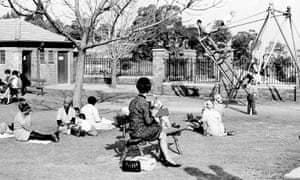
Nadine Gordimer
John Currin
A brief survey of the short story part 73
NADINE GORDIMER
Rebel, radical, relic? Nadine Gordimer is out of fashion – we must keep reading her
Consider her 1947 story Is There Nowhere Else We Can Meet?, which describes a violent encounter between a young white woman and a black man on a lonely country path. From the outset, Gordimer draws our attention to the physical: as she walks, the woman idly runs a twist of pine needles against her thumb, “catching in gentle resistance as the minute serrations snagged at the skin”. The man’s leg and heel, visible to the woman through his ragged clothing, “showed the peculiarly dead, powdery black of cold”. When he runs at her, she turns to find him “panting right into her face”, and they wrestle until she eventually breaks away. The woman’s escape highlights the contrast between the perilous countryside – “She ran and ran, stumbling wildly off through the stalks of dead grass, turning over her heels against hard winter tussocks, blundering through trees and bushes” – and the reassuring security of suburbia: “And she was out. She was out on the road. A little way on there were houses, with gardens, postboxes, a child’s swing. A small dog sat at a gate.” It is as if in leaving the path and scaling a fence, she has passed from a nightmare into reassuring wakefulness. But the opposite reading might also be true: the hostile land beyond the fence is real, and the manicured zone it protects nothing more than a dream that, sooner or later, will end.
This idea of the South African society Gordimer lived in – first in the mining town of Springs, later in Johannesburg – being a countrywide illusion, is one her work often returns to, and which she described in a 1963 essay: “The ‘problems’ of my country did not set me writing; on the contrary, it was learning to write that sent me falling, falling through the surface of ‘the South African way of life’.” The young woman’s encounter with the black man in Is There Nowhere Else We Can Meet? has momentarily torn a hole in this surface. Still reeling, she asks herself why she didn’t simply give the man the money he presumably wanted from her. “What did I fight for?” she wonders. This could be a pragmatic response to a dangerous situation, but when read back through Gordimer’s subsequent work, which charted her own development from liberal to radical, and her belief in the necessity of, as she wrote in 1976, “a black majority government elected by unqualified franchise”, it’s possible to detect a more profound yearning in the young woman’s thoughts, a yearning amplified by the story’s title.
Once this idea takes root, all the white Africans in Gordimer’s fiction seem to know, whether they admit it or not, that they don’t quite belong. This sense of alien incursion is powerfully communicated by Inkalamu’s Place (1965), in which a UN worker drives out into the country to visit a grand house she knew in her childhood. Inkalamu Williamson lived there, an Englishman who took “native women” as his wives, and had a brood of children that were “all shades of brown and yellow-brown, quite different from Inkalamu and my father and us”. She finds the red mud house in a state of collapse and “blurred with overgrowth”. Yet she can still see it as it was, “three storeys tall, a sandcastle reproduction of a large, calendar-picture English country house”. The ruined white man’s house, in the final stages of being reclaimed by mango trees and forest plants, feels like something from a story by Conrad, as if the aftermath of some variant of Heart of Darkness or An Outpost of Progress has been stumbled on decades later.
It becomes clear, as the narrator brings adult wisdom to bear on her childhood memories, and when she meets one of Inkalamu’s daughters running a nearby store, that Inkalamu took more than he gave. He didn’t properly educate his children or make much provision for them, having sold off most of his land before he died. “I was glad that the Williamsons were rid of their white father, and could live,” the narrator states, although she does not recognise the barriers Inkalamu’s mixed-race children face. (Albeit not necessarily apartheid: the precise setting of Inkalamu’s Place isn’t revealed.)
In her 1953 story Six Feet of the Country, narrated by a white man who has moved with his wife to a farm 10 miles outside Johannesburg, we see Gordimer’s growing disdain for liberalism. (“I am a white South African radical,” she told the Times in 1974, “do not call me a ‘liberal’.”) This man might mock the “look of insanely inane certainty” exhibited by “all who are possessed by the master-race theory”, but his own views prove to be retrograde:
In the country, there is a lingering remnant of the pre-transitional stage; our relationship with the blacks is almost feudal. Wrong, I suppose, obsolete, but more comfortable all around.
When the brother of Petrus, one his farmworkers, dies on his property, he notifies the authorities because the man had crossed into South Africa from Rhodesia without a permit. When Petrus asks his boss to get the body back so his family can bury him, the narrator becomes enmeshed in a maddening bureaucratic exchange that reveals how little a black body was worth under apartheid. Gordimer’s narrator glimpses the awfulness of the system of which he is a passive supporter and beneficiary, then pushes the realisation away. At the story’s end he considers the dead man’s father – who has gone back to Rhodesia without his son but with a suit – to have done quite well out of the episode. Gordimer would reuse this outline in her novel The Conservationist, which won the Booker prize in 1974.
 |
| Crowds at Sharpeville on 21 March 1960, a few hours before police opened fire. Photograph: Anonymous/AP |
South Africa’s worsening political climate runs like a tidemark through Gordimer’s stories. Not all of them are directly political – she is just as interested in extramarital affairs as John Updike or James Salter (her 1984 story Sins of the Third Age is particularly Salterian), and she also wrote stories about humans pitted against nature, such as The Gentle Art (1960), a vivid piece about a night-time crocodile safari.
But her work underwent a tonal shift during the 1960s, and comes to express a more militant point of view in the 1970s and 80s. In 1975 she published Town and Country Lovers, one of her most coldly furious critiques of apartheid. The first section of the story describes a relationship between a white Austrian geologist working for a mining company and a black shop girl. Their affair, movingly described, has a bleak loneliness to it that arises from its prohibition: “On Sundays she got into his car in the basement garage and they drove to the country and picknicked away up in the Magaliesberg, where there was no one.” Gordimer relates their arrest with stark simplicity, the flat, their haven, seeming to shake with the policemen’s “strong, unhurried blows” on the door. From this moment the narrative becomes procedural, and the lovers become subjects to be examined:
They were taken to the police station where they were at once separated and in turn led for examination by the district surgeon. The man’s underwear was taken away and examined, as the sheets had been, for signs of his seed … Her thighs and knees trembled uncontrollably while the doctor looked into her and touched her deep inside with more hard instruments, carrying wafers of gauze.
After this come court statements and a newspaper report. “I lived with the white man in his flat,” the woman says. “He had intercourse with me sometimes. He gave me tablets to prevent me becoming pregnant.” “Even in my own country,” the man tells a reporter, “it’s difficult for a person from a higher class to marry one from a lower class.” Tessa Hadley has called these closing words “horrible dead things”, and they are; we have witnessed such intimacy between these lovers that to see them be reduced to strangers again is profoundly sapping. Their story doesn’t build to a climax, but drains away to a grim emptiness.
The second section, about the relationship between Paulus, a white farmer’s son and Thebedi, the daughter of one of the black farmworkers, is an even more menacing portrait of South Africa’s race laws. “The farm children play together when they are small,” it begins, “but once the white children go away to school they soon don’t play together any more”. Paulus is aberrant, continuing to show affection to Thebedi; by the time he leaves school they are lovers. She marries another farmworker, but is already pregnant with Paulus’s child. Returning from college, Paulus discovers that Thebedi has a “very light” baby, with “a quantity of straight, fine floss” on its head. When he murders the child, it’s uncertain whether he does so through fear of discovery or genuine disgust. Most likely it is some hideous combination of the two: the state’s laws promote fear and disgust of the other, even when that other was once beloved. But it is the uncertainty that is Gordimer’s masterstroke.
If Town and Country Lovers describes how the South African state could control its inhabitants, Something Out There (1984) looks at a different response: violent resistance. Although it is technically a novella, I want to include it here in part because it’s one of the best things Gordimer wrote, and also because she chose it for inclusion in her final volume of selected stories. The contrast between the “tension” described by the narrator of Six Feet of the Country and the South Africa portrayed in Something Out There is stark. In the opening few pages, Mrs Klopper, one of Gordimer’s most acerbic examples of conservative Afrikaner womanhood, explains why she doesn’t have black servants:
I don’t want anyone in my place, I don’t want all that business of having to lock up my sugar and tea – no, I’ll rather do everything myself. I can’t stand to feel one of them there at my back all the time.
Gordimer entwines two storylines: the first is about a wild, humanoid animal (it turns out to be a baboon) that terrorises an affluent Johannesburg neighbourhood. The second is about a revolutionary cell, two of whom are white and two black, who rent a farmhouse outside the city and prepare an attack on a nearby power station. Gordimer exploits the dramatic irony of the white suburbanites’ fear of the creature rampaging in their midst while the real-estate agent and his wife consider the white revolutionaries – terrorists, they will later call them – to be upstanding young people, and their black colleagues, who are the key operatives with the technical expertise required to handle explosives, just “houseboys”.
The fragmentary structure of Something Out There allows Gordimer to carry out an unusually wide survey of South African society, moving from residents’ association meetings to revolutionary training camps, art galleries to ancient mines, and combines several of Gordimer’s primary modes: the lyrical, the social, the comedic, the political, and, most prominently, the ironic. No matter how briefly they appear, every character is made real. Yet finally it is a national atmosphere that the novella depicts, the atmosphere of a country where the prime minister makes speeches about a “total onslaught”, where a husband warns his wife not to chase black thieves because “they’ll knife you if you catch them”, where terrorists are seeping across the borders with Zimbabwe and Mozambique, and where “whatever you do, you can’t call yourself safe”.
Something Out There marks the end of Gordimer’s most accomplished period, which began with the collection Livingstone’s Companions in 1970, and encompassed the novels The Conservationist, Burger’s Daughter and July’s People. She won the Nobel prize for literature in 1991, and wrote several more novels and story collections in the 1990s and 2000s, but the standard of these books is erratic. In truth, all her story collections are erratic. In the New York Times in 1984, Salman Rushdie called Letter from His Father, a story in Something Out There in which Gordimer imagines a response to Franz Kafka’s famous Letter to His Father, “an unmitigated disaster”, and he was right.
The real pity is that, of all the stories Gordimer wrote, only her final two collections remain in print and they are probably the poorest examples of her work. The career-spanning anthology Life Times is the better option, but it would be possible to compile a far superior single volume of her short stories that showed the true scale of her achievement. There is little eagerness for such a project at the moment, however. Gordimer died in 2014, and she is currently in the doldrums many writers enter in the years immediately after death. She has only been mentioned in this paper a handful of times since she died, and Hedley Twidle, a senior lecturer at the University of Cape Town, tells me she is barely read in South Africa today. Her reputation is further hampered by the work she wrote from a black perspective, which were controversial then and remain so now, when the question of who has the right to tell certain stories is such a vexed one. It doesn’t help that these stories, the most prominent being Oral History (1980) and The Ultimate Safari (1988), are far from her best work.
THE GUARDIAN









.jpg)


0 Yorumlar